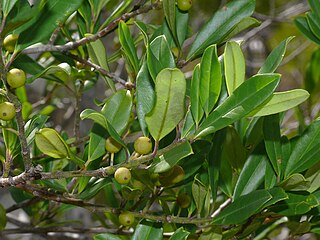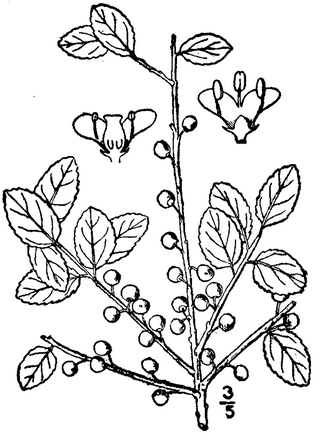
Yerba mate or yerba-maté is a plant species of the holly genus Ilex native to South America. It was named by the French botanist Augustin Saint-Hilaire. The leaves of the plant can be steeped in hot water to make a beverage known as mate. Brewed cold, it is used to make tereré. Both the plant and the beverage contain caffeine.

Quercus ilex, the evergreen oak, holly oak or holm oak is a large evergreen oak native to the Mediterranean region. It is a member of the Ilex section of the genus, with acorns that mature in a single summer.

Ilex opaca, the American holly, is a species of holly, native to the eastern and south-central United States, from coastal Massachusetts south to central Florida, and west to southeastern Missouri and eastern Texas.

Ilex cassine is a holly native to the southeastern coast of North America, in the United States from Virginia to southeast Texas, in Mexico in Veracruz, and in the Caribbean on the Bahamas, Cuba, and Puerto Rico. It is commonly known as dahoon holly or cassena, the latter derived from the Timucua name for I. vomitoria.

HMS Ilex was one of nine I-class destroyers destroyer built for the Royal Navy during the 1930s. She is the only ship of the Royal Navy ever to have been named after Ilex, the genus of flowering plants commonly known as holly.

Ilex vomitoria, commonly known as yaupon or yaupon holly, is a species of holly that is native to southeastern North America. The word yaupon was derived from the Catawban yą́pą, from yą- tree + pą leaf. Another common name, cassina, was borrowed from Timucua. The Latin name comes from an observation by early Europeans that the ingestion of the plant was followed by vomiting in certain ceremonies.

Ilex verticillata, the winterberry, is a species of holly native to eastern North America in the United States and southeast Canada, from Newfoundland west to Ontario and Minnesota, and south to Alabama.

Black drink is a name for several kinds of ritual beverages brewed by Native Americans in the Southeastern United States. Traditional ceremonial people of the Yuchi, Caddo, Chickasaw, Cherokee, Choctaw, Muscogee and some other Indigenous peoples of the Southeastern Woodlands used the black drink in purification ceremonies. It was occasionally known as white drink because of the association of the color white with peace leaders in some Native cultures in the Southeast.

Ilex aquifolium, the holly, common holly, English holly, European holly, or occasionally Christmas holly, is a species of flowering plant in the family Aquifoliaceae, native to western and southern Europe, northwest Africa, and southwest Asia. It is regarded as the type species of the genus Ilex, which by association is also called "holly". It is an evergreen tree or shrub found, for example, in shady areas of forests of oak and in beech hedges. In the British Isles it is one of very few native hardwood evergreen trees. It has a great capacity to adapt to different conditions and is a pioneer species that repopulates the margins of forests or clearcuts.

Ilex montana, the mountain winterberry, is a species of holly native to the Eastern United States, ranging along the Appalachian Mountains from southeast Massachusetts to northeast Alabama and northern Georgia. Synonyms include Ilex monticola.

Ilex mucronata, the mountain holly or catberry, is a species of holly native to eastern North America, from Newfoundland west to Minnesota, and south to Maryland and West Virginia.

Ilex guayusa is a species of tree of the holly genus, native to the Amazon Rainforest. One of four known caffeinated holly trees, the leaves of the guayusa tree are harvested fresh and brewed like a tea for their stimulative effects.

Kuding is a particularly bitter-tasting Chinese infusion, which due to their similarities in appearance is derived from several plant species. The two most common plants used to make kuding are the wax tree species Ligustrum robustum and the holly species Ilex kaushue, the former being more commonly grown in Sichuan and Japan while the latter is most commonly grown and used in the rest of China. Tea produced from Ligustrum or many species of Ilex is caffeine-free, although not Ilex paraguariensis, the source of mate drank in South America.

Ilex glabra, also known as Appalachian tea, evergreen winterberry, Canadian winterberry, gallberry, inkberry, dye-leaves and houx galbre, is a species of evergreen holly native to the coastal plain of eastern North America, from coastal Nova Scotia to Florida and west to Louisiana where it is most commonly found in sandy woods and peripheries of swamps and bogs. Ilex glabra is often found in landscapes of the middle and lower East Coast of the United States. It typically matures to 5–8 ft (1.5–2.4 m) tall, and can spread by root suckers to form colonies. It normally is cultivated as an evergreen shrub in USDA zones 6 to 10.

Ilex decidua is a species of holly native to the United States.

Ilex or holly is a genus of over 570 species of flowering plants in the family Aquifoliaceae, and the only living genus in that family. Ilex has the most species of any woody dioecious angiosperm genus. The species are evergreen or deciduous trees, shrubs, and climbers from tropics to temperate zones worldwide. The type species is Ilex aquifolium, the common European holly used in Christmas decorations and cards.

Ilex mitis is a tall, dense, evergreen tree that is indigenous to Sub-Saharan Africa and Madagascar. It makes an excellent fast-growing hedge for gardens - growing tall, straight and dense.

Ilex cornuta, commonly known as Chinese holly or horned holly, is a slow-growing, densely foliaged evergreen shrub in the Aquifoliaceae plant family. It is native to eastern China and Korea and attains a height of about 3 metres (9.8 ft). The leaves are usually 5-spined, between 3.5 cm and 10 cm long, oblong and entire. The fruits are red berries, which are larger than those of the European Holly.

Tarzan: Return to Pal-ul-don is a novel written by Will Murray featuring Edgar Rice Burroughs's jungle hero Tarzan. It is the first volume in The Wild Adventures of Tarzan, a series of new works authorized and licensed by Edgar Rice Burroughs, Inc. It was first published by Altus Press in June 2015 in trade paperback and ebook.

Eagle House is a Grade II* listed building in Batheaston, Somerset, near Bath. Before World War I the house had extensive grounds.



















